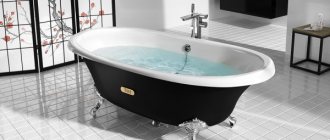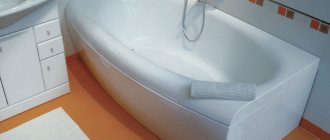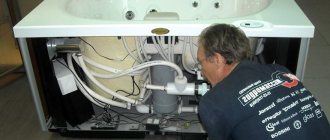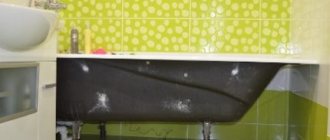The debate about the need to ground bathtubs continues. Some argue that it is not necessary. Others provide reasonable explanations for why grounding is important to ensure the safety of apartment residents. Experts believe that a protective circuit is still needed. While there was no alternative to metal pipes, grounding a bathtub in an apartment was done simply - the plumbing was connected to a metal riser.
But now the situation has changed: if the neighbors below replace some sections of pipes with plastic, the grounding disappears. Therefore, now we have to connect the bath to the grounding bus on the distribution board.
Theory
Many electronic household appliances these days have small metal grooves designed for grounding. This term refers to a special protection that takes electric current when it appears on the body of an object and leads it to the ground.
Everyone in their life has experienced mild electric shocks when touching electrical appliances. Quite often this can happen if you touch a computer, washing machine or heating tank. In the latter case, this occurs due to the formation of a hole in the heating element, which causes electricity to pass through the water.
Often this happens because the electrical wiring in our homes was not installed properly. If there are grounding devices, this problem will not cause inconvenience.
Is an acrylic bathtub grounded?
Nowadays, acrylic bathtubs, which are lightweight and affordable, are especially popular.
Although this is a polymer that is dielectric (i.e. does not conduct current), such a bath still needs to be grounded for the following reasons
:
- casting and extrusion are two methods of producing acrylic bathtubs. Polymer produced by extrusion does not retain its shape well. It is the bowls made in this way that must be installed in a steel frame, which must be grounded;
- The acrylic bathtub is also grounded in order to remove static voltage. If the bowl is large, then this must be done, as this can lead to the bathtub accumulating a strong electrical charge.
What are the dangers of lack of grounding in the bathroom?
A person can become energized anywhere in an apartment, but the most dangerous areas are those with running water: the bathroom, toilet and kitchen.
Water with substances dissolved in it has good conductivity and flows through metal pipelines in contact with the ground. A pipeline has already been practically prepared through it to remove the electrical charge. You just need to apply potential to it and electric current will flow along this path into the ground. A person caught between potential and ground will be exposed to electric current.
Such a situation cannot be allowed. And the construction practice that has developed over decades since Stalin’s times allowed it. Then it was necessary to create a lot of housing for people in a short time. Therefore, they neglected safety, saved money at its expense, and gained time. Unfortunately, they made it the norm, actually legalized it. This trend is firmly rooted in the minds of many people to this day.
The way out of this situation is to completely exclude the possibility of exposure to electric current on a person. This requires the complete removal of electrical devices. But this method is not feasible.
Therefore, a compromise is applied: the number of electrical appliances used is limited while their quality is increased, allowing safe operation even in rooms with high humidity.
Video on the topic
Protective grounding of a bathtub in an apartment is done for many reasons, the main one of which is increased humidity in the room and the associated risk of current leakage to the ground. This is explained by the fact that water poured into a bathtub is a conductor of electricity, and the bathtub itself, one way or another, is in contact with the ground.
People unfamiliar with the basics of electricity, when discussing whether it is necessary to ground a bathtub, reason as follows. “Why ground the bathtub,” they say, if it is isolated from the floor screed by a layer of ceramic tiles?
But at the same time, many people forget that its metal body is still connected to the ground through a system of water and sewer pipes.
Because of this, the touch of a washing person to a faulty electrical appliance (an electric razor wire with broken insulation, for example) can cause dangerous electric shock.
Therefore, making grounding in the bathroom is a primary task to protect the user from strong electric shock.
Let's add to this that reliable grounding in the bathroom has a threefold function:
- firstly, when a dangerous leak appears, it triggers a protective device (RCD), which instantly de-energizes the room;
- secondly, if due to low currents the RCD did not work (or turned out to be faulty), then if there is grounding, the voltage at the point of contact will drop for some time to a safe level;
- and finally, it equalizes the potential of all metal objects in the bathroom connected to a common grounding device (GD) for the house.
In the second case, the probability of a critical injury to a person who has felt an electric shock is much reduced, which becomes the answer to the question of why grounding a bathroom is needed.
What is bath grounding and why is it necessary?
The modern bathtub is one of the most dangerous places in the house. In most cases, they are made of metal, which is a good conductor of electric current. For convenience, sockets and additional light switches are often installed in close proximity to the bowl body itself. There is a certain risk to human health (electric shock). Therefore, in order to avoid the sudden appearance of an electrical discharge, you need to ground the bathroom in the apartment.
In our country, the requirements for this procedure are regulated by special norms and rules. Therefore, it is best to seek help and advice from experienced professionals. At its core, grounding a bathtub is a connection between the bowl body and a wire, which in turn has a connection to the ground (floor). If there is one, then a charge (including a statistical one) that suddenly appears on the body will “go” to the floor without causing any trouble.
Grounding the Jacuzzi
“Jacuzzi” is a hydromassage bath that operates on a 220V network and has a frequency of 50 Hz.
To connect and install the hot tub, there must be a separate grounded outlet in the room. It should be equipped with curtains that block access to the plug. In addition, a third plug is required, which will play the role of grounding. This outlet is protected from splashing water, so there is no risk of a short circuit.
The socket must be mounted at a height of at least 50 cm from the floor and at a distance of at least 70 cm from the side of the jacuzzi. Double or triple insulated cable is used for wiring.
It is necessary to install a machine that can withstand a load of 16 Amps so that there is no possibility of damage to the electrical equipment of the bath, which can be caused by a sudden voltage drop. Also, an RCD device should be located outside the bathtub.
Using a Jacuzzi that is connected to an ungrounded outlet is strictly prohibited.
In addition, the Jacuzzi cannot be grounded through the heating, sewage and water supply systems.
This work should only be carried out if the Jacuzzi is disconnected from the electrical network. If the electrical cord is damaged, then you should not use such a bathtub; it is better to call professionals who will repair or replace it.
Grounding a metal bath
The normal method of electrical installation is to connect the bath with a special connection using a special grounding bus. The busbar must be located on the distribution board.
This connection must be made in any room with a bathroom where there is electrical equipment.
Many apartments and houses are equipped with Soviet baths. If you have just such a plumbing fixture installed, then it is grounded as follows:
:
- A hole is drilled in the foot of the bathtub using an electric drill with a Pobedit drill bit. Subsequently, the grounding jumper is secured with a bolt, nut and washer;
- The multi-core cable must be screwed to the bathtub leg on one side and to the distributor on the other. All wires from metal devices must be connected to this cable;
- The distributor is mounted on the wall in a convenient place. It is brought out to the grounding bus of the input shield, which is located in the entrance;
Bathtubs made of steel and cast iron, produced recently, are equipped with a special “petal”, which is used for grounding. The ground wire is connected to it.
In this case, you just need to strip the cable and clamp it between the petal washers, securing it with a bolt and nut;
If the bathroom has a shower equipped with an instant water heating function, or a heating tank, then they also need to be grounded. The jumper in this case is made as follows: the metal elements of the device housing are connected to grounded pipes.
Why and how do you need to ground plumbing?
Every year more and more electrical appliances and metal objects appear in apartments. The bathroom is no exception to the general rule. The bath itself also became a source of increased danger. This applies not only to steel and cast iron models, but also to acrylic ones.
Although acrylic does not conduct electricity, any container made from it can accumulate a powerful static charge. The situation is not improved by the fact that acrylic bathtubs are often installed on a metal frame, which is a good conductor of electricity.
A specialist explains the relevance of grounding a bathtub in an apartment:
Old Soviet-style bathtubs are usually made of cast iron and steel. They do not provide special devices for grounding. But it's not a problem. It is enough to drill one of the legs and install a ground jumper.
Such jumpers are secured with ordinary bolts and nuts. Modern models are already more convenient.
If in high-rise apartments the risers and pipes have not been replaced with plastic ones, grounding the bathtub is very simple. The electric current is carried out through a metal wire attached to the riser. This option is not suitable for modern apartments where the risers have already been replaced with plastic
Manufacturers install a so-called petal - an ear-shaped metal device to which a grounding wire can be attached. It is connected in series to metal objects, water heating equipment, electrical appliances and output to the switchboard.
If in old bathtubs you have to make holes for the grounding wire yourself, then with modern models there are no such problems. Manufacturers have pre-provided a petal at the bottom of the structure in accordance with all electrical safety rules
Special requirements apply to the grounding of hot tubs. Such plumbing equipment is connected only to a separate grounded outlet. According to electrical safety rules, the socket is placed 30-50 cm from the floor and 50-70 cm from the edge of the bathtub. To prevent plumbing equipment from breaking down and causing danger in cases of voltage surges, an RCD is installed outside the room.
Although the installation procedure of grounding devices itself is not complicated, it should be entrusted to qualified electricians. Without the necessary skills, it is undesirable to experiment on your own.
Grounding of hot tubs should be done by specialists. They will correctly connect the equipment of the bath itself and the grounding wires. When the work is completed, all unaesthetic elements can be hidden behind a decorative screen
Option #1: Grounding an old-style bathtub
To ground a bathtub without a special eyelet, you will need the following materials and tools:
- electric drill;
- Victory drill;
- ground jumper;
- fasteners: bolt, washer, nut;
- multi-core cable.
Drill a hole in the bathtub leg, then screw the ground jumper to it, securing it with a bolt, washer and nut. Attach a multi-core cable to the jumper and connect it to the distributor. The distributor itself must be mounted on any convenient wall and brought to the switchboard, to the grounding bus. In addition to the distributor, the remaining cables from all metal objects located in the bathroom are connected.
Electrical safety rules require connecting all metal bathroom appliances to one common ground bus. Thanks to this, you can avoid the negative influence of stray currents, which often cause rapid pitting of metal pipes in water supply and sewerage systems
Option #2: How to ground cast iron plumbing?
If the cast iron bathtub has been manufactured within recent years, there should be no difficulty in grounding it. The design has a pre-installed jumper with an eyelet for connecting the cable - a petal. The part of the wire intended for connection to the bath is exposed and clamped between the washers using a bolt and nut.
A water heater or other electrical appliances also have parts that serve for grounding. They are connected according to the same principle. However, difficulties often arise with grounding the heated towel rail. A do-it-yourself solution to this problem:
If for some reason there is no grounding tab on the bathtub, you need to attach it yourself. It is best to connect it not to the legs themselves, because... There is not enough contact between the legs and the bathtub container, and to other parts. For example, for drilling a hole for grounding, a structural element designed for wedging the legs of a plumbing fixture is well suited. In appearance, these parts look like extensions from the body.
Here you can make a hole up to 1 cm deep without the risk of damaging the bathtub container. If you attach the ground wire to the housing, reliable contact will be ensured. You can also install it on the “wings” of the bathtub.
You can make a hole for grounding both on the bathtub leg itself and in the part of the body to which it is attached. The second option is preferable, since in this case contact with the metal container is ensured. If you choose “wings” as an alternative, then you need to take into account that the depth of the hole here will be no more than 5 mm. It may be difficult to select the length of the screw
Option #3: What to do with the steel model?
There are no problems at all with steel baths. The grounding wire is attached in the same way as for cast iron models. Most often the petal is already there, and there is no need to drill anything. However, when fastening the crimp screw, it is worth clearing the enamel from the hole. Clean the enamel coating down to the metal. This will ensure complete grounding.
Grounding of any metal bath is carried out according to one scheme. The only difference is that when attaching the wire to a steel model, it is advisable to clean the enamel
Option #4: Features of grounding acrylic bathtubs
Acrylic bathtubs are becoming more and more popular. They are chosen by many apartment owners. One of the main advantages of acrylic models is lightness. At the same time, this property is also a disadvantage. Lightweight products are not stable, and lightweight bathtubs are no exception. To install them, frames are used.
Many manufacturers complete their products with metal frames, and buyers consider this installation option to be optimal. If grounding is not so important for a bathtub on a brick or wooden frame, then for steel it is mandatory.
Depending on the manufacturing method, cast and extruded acrylic bathtubs are distinguished. Models of the second type “rely” on metal frames. It is advisable to organize grounding for bathtubs with less “dangerous” frames. This is due to the fact that water is a conductor of electricity, and although acrylic itself is a dielectric, the container can accumulate a considerable charge of static electricity.
There is usually a special jumper for grounding. If you come across a model without it, you should drill a hole in the same way as in metal baths. The outer coating must be scraped off, as when grounding steel baths, since the paint is a dielectric.
Acrylic models also need grounding, especially if metal is used as a mounting frame. After completion of the work, the connection to all communications will be masked, the appearance of the bath will not be affected
Option #5: How to ground a hot tub?
Hot tubs must be grounded. If there are still disputes regarding other types, then for plumbing equipment operating from an electrical network with a voltage of 220 V, the issue has been initially resolved. A separate outlet is installed for the hydromassage bath. Choose a model with a “curtain” that protects the device from splashes of water that may occur while swimming with hydromassage. This “curtain” looks like a small door on a socket.
Such sockets can be purchased at any hardware or hardware store. You need to choose a model with a third (grounding) plug. To connect the hot tub socket, wires with two layers of insulation are used.
Ideally, the installation of the device should be carried out by an electrician. If you do not have the appropriate experience, electrical installation work can pose a danger to life and limb. There is a high probability of errors when installing or connecting devices.
The minimum distance from the socket to the floor is 30 cm, to the edge of the jacuzzi - 50 cm. Outside the room, an RCD and a 16 A circuit breaker should be installed. The electric cable is placed in a corrugated tube. Grounding the hot tub through any plumbing equipment is prohibited due to safety regulations. If there are problems with grounding, the device cannot be used until all problems have been corrected.
To prevent hot tub equipment from being damaged by power surges, it is best to install a voltage stabilizer. This will ensure maximum safety for people when using plumbing equipment.
Hot tubs that are not properly electrically connected can pose a potential hazard to human life. Connections should be made in accordance with standard electrical installation regulations.
Cable laying and self-installation
To carry out grounding yourself, you need to select a suitable wire. It must be selected according to the following characteristics:
- the cable must have the necessary rigidity and have a cross-sectional area of 6 square meters. mm;
- the wire must have yellow-green insulation made of PVC material;
- The cable length should be selected individually. It is preferable to choose a wire from 2 m, but keep in mind that an excessively long cable will cause a breakthrough;
- The aesthetic aspect is also important. You probably won't like it if the wires are in plain sight. Hide them behind panels or a screen, or place them on the side of the bath that is practically invisible;
- To save money, steel is usually used as grounding electrodes, but steel enclosed in a copper sheath, or simply copper, has higher efficiency rates.
Grounding a bathtub can be done according to some general rules:
- Manufacturers do not forget to supply all modern bathtubs with a separate grounding petal. It looks like an ear with a hole. A grounding wire is connected to such a petal;
- its bare fragment is clamped between washers, which help secure the bolt and nut;
- if the bathtub was made in the Soviet era, then you need to drill a hole in the leg or on the wing of the bathtub and in exactly the same way, using washers, a bolt and a nut, secure the grounding jumper.
If you do not have enough experience in electrical engineering and installation work, then it is better to contact a professional electrician who will do the grounding for you himself. But even if you did it yourself, a specialist should check the functionality of the grounding jumper. Otherwise, you risk undesirable consequences.
There is another important point: many people confuse grounding with grounding. These are slightly different things, since grounding is used only for industrial purposes, but not for domestic purposes. And the confusion stems from the fact that in apartments lately they have been doing zeroing very often. This applies to both water heaters and washing machines. But it is not recommended to carry out zeroing in residential buildings, although at the same time it is not prohibited. Just imagine that the neutral wire burns out for some unknown reason or that the electrician accidentally connects a phase instead of zero. As a result, all your devices will simply burn out from excessively high voltage. Yes, both the purposes of grounding and grounding are somewhat different. Grounding is designed solely for the occurrence of a short circuit.
Selecting components for bath grounding
Typically, in apartments and private houses, a stranded wire with a cross-sectional area of at least 6 square meters is used for grounding and grounding. mm. This cross-sectional area of the grounding conductor is quite sufficient to provide protection against electric shock to a person in residential premises. It is better to choose a copper cable, but in extreme cases you can use aluminum wire or copper-sheathed steel wire. The grounding conductor should be masked. This is necessary not only from an aesthetic point of view, but also to protect the grounding from accidental damage. Usually the cable is hidden in bathroom furnishings, behind screens and plastic panels. To connect the grounding of all items in the bathroom to a common bus, use a special distributor.
DIY grounding instructions
When everything fell into place with theory, it’s time to start practicing. The issue of grounding in an apartment can become a serious problem if the house does not have a grounding loop. But this can be easily fixed if you have the desire and opportunity. Select the right materials and tools, and then start installing the wire.
Step 1 - choosing materials before starting work
First you need to decide what materials to purchase for electrical work. After all, you definitely need to choose the right cross-sectional area of the wire, its type, and not make a mistake with the amount of consumables.
In addition to this basic element, you will need:
- potential equalization box;
- RCD for the required number of Amperes;
- terminals;
- pipe clamps.
The potential equalization box is a plastic compartment in which all branches of the ground wire are connected.
Since it is prohibited to ground objects in series, a separate cable must go from each device or pipe to the potential equalization box (PEC).
Features of the modern method of grounding bathtubs
In accordance with the standards for safe work performance, the grounding of the bath is carried out through a grounding bus, which is located on the common distribution board.
Important! In new buildings, there is no need to think about how to ground the bathroom, since such work has already been completed. In other cases, such a procedure is necessary, and the amount of equipment in this room does not matter. Unfortunately, in many apartment buildings of old buildings there is simply no grounding, but if it has been reconstructed, then you can safely begin work on protection from exposure electric shock in the bathroom
In this case, you should not use the “old-fashioned” method, simply connecting the bowl to a sewer or water supply riser. In modern conditions, this option is not at all suitable, since many have replaced old pipes and risers with plastic.
Unfortunately, in many old apartment buildings there is simply no grounding, but if it has been reconstructed, then you can safely begin work on protection from electric current in the bathroom. In this case, you should not use the “old-fashioned” method, simply connecting the bowl to a sewer or water supply riser. In modern conditions, this option is not at all suitable, since many have replaced old pipes and risers with plastic.
Having decided on the need to ground the bathroom, you can invite a specialist, or do everything yourself, but you must follow the rules:
- The grounding wire must have a sufficient cross-section; for a bathroom this value is 6mm².
- Be sure to check the reliable PVC insulation, which should have a yellow-green color. The length is selected depending on specific conditions, but the wire cannot be less than 2 meters. It must be laid in such a way as to prevent accidental damage and spoil the appearance of the room, for example, inside the walls, behind a decorative screen, etc.
- If electrical devices that heat water are installed in the room, the grounding connection must be made through a protective device, which will ensure timely shutdown if necessary.
Important! When choosing grounding electrodes, preference should be given to copper products, since compared to steel, they are more reliable and efficient. Savings in this case are inappropriate! Nowadays in bathrooms there are both old, but still relevant steel and cast iron bathtubs, as well as more modern options - made of acrylic
“Jacuzzi” is also common. Despite the fairly large similarity of the work performed, each of these options has some features that you should be aware of in order not to make mistakes when solving the question: “How to ground a bathtub?”
Nowadays in bathrooms there are both old, but still relevant steel and cast iron bathtubs, as well as more modern options - made of acrylic. “Jacuzzi” is also common. Despite the fairly large similarity of the work performed, each of these options has some features that you should be aware of in order not to make mistakes when solving the question: “How to ground a bathtub?”
Grounding an acrylic bathtub
But what about acrylic, is it necessary to carry out grounding, how is the process carried out, how to do everything yourself?
An acrylic bathtub is made of a polymer material that is not a conductor of electric current. But as mentioned above, acrylic accumulates static stress. And some products on the market today are equipped with metal legs for secure mounting, in which case grounding is recommended.
Recently, acrylic has become increasingly popular, and many consumers prefer to purchase bathtubs made from this material. It’s not often steel that attracts interest, much less cast iron. The main feature of acrylic and its advantage is its low weight, but on the other hand, this parameter is also a disadvantage. Manufacturers offer two types of acrylic bathtubs:
- 1. Cast.
- 2. Extruded.
The second option is usually installed on a steel frame, and as already mentioned, metal is an excellent conductor of electric current. That is why you still need to ground the acrylic bathtub to protect yourself. The grounding process is carried out by analogy with metal products.
It is important to understand that this procedure is best performed due to the fact that moisture can accumulate between the body of the acrylic product and the metal frame, and this already leads to the formation of a conductive layer.
Accessories for the job
What is required to ground the bathtub? The list of required materials is small and includes:
- 1. Ground wire. It is best to have a stranded copper wire with a diameter of at least 6 millimeters. In accordance with color marking requirements, the color of the insulation should be yellow-green.
- 2. Potential equalization box. You will also need clamps to complete the work.
- 3. Bolt with nut and washer.
It is recommended to mask the wire during operation, this is necessary so as not to accidentally damage the wiring. And this is necessary from an aesthetic point of view. Wiring is often hidden behind plastic panels, screens, or in pieces of furniture.
Which bathtub should be grounded?
The modern market offers bathtubs made of different materials:
- 1. Cast iron.
- 2. Steel.
- 3. Acrylic.
How to make grounding in a bathroom with an acrylic bathtub? It must be said that no one has problems with either cast iron or steel; there are often questions regarding acrylic, how to ground a bathroom, and thereby protect yourself and all family members.
There is an opinion that acrylic itself is an excellent insulator and there is no point in grounding a bathtub in an apartment from such a material. But some people claim that acrylic in turn accumulates static electricity, and to remove this potential, it is recommended to ground it.
The power of static voltage is insignificant, and it does not pose any threat to humans, although its value is quite high. And if we talk about rooms where there is a high level of humidity, then there is no static voltage at all.
In addition, a logical question arises, if necessary, how to ground a plastic bathtub?
There is one nuance here that is worth considering; installation is carried out on a metal frame, which in turn is an excellent conductor of electric current. That is, the process of grounding an acrylic product is still necessary, as is the case with cast iron and steel.
Why is it so important to ground your bathtub?
Everything you need to ground your bathroom
Water is an excellent conductor of electricity, so the bathroom will always be one of the most unsafe places in your home. Where there are a lot of metal pipes, as well as installation products, and all this is combined with a humid microclimate, in order to prevent accidents, it is necessary to strictly adhere to the rules and regulations of safe electrical installation.
Metal equipment that is not related to electricity: sewer and water pipes, radiators, bathtubs, sinks, etc., can cause the most dire consequences if, for example, a fuse suddenly trips. As a result, it is necessary to organize grounding in the bathroom and thereby prevent the formation of dangerous voltage on the metal parts of the equipment.
Note!
Previously, this was how bathtub protection was carried out: grounding was done by connecting its bowl to a sewer or water riser.
Now, if you live in an apartment building, you cannot do this, under no circumstances!
If your neighbors downstairs in their apartment replace the iron water supply or cast-iron sewer riser with plastic pipes, then you will not have grounding. Moreover, you will get an increased capacitor area, with all the sad consequences arising from this circumstance.











